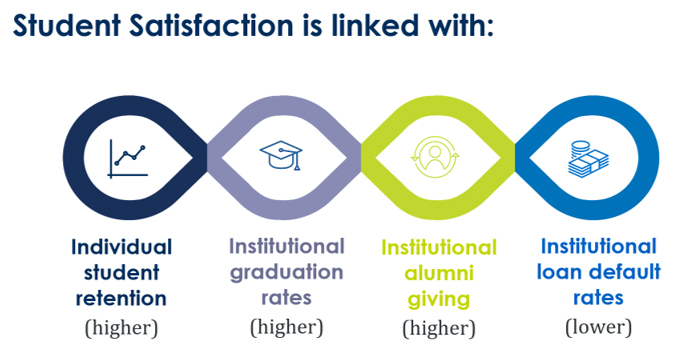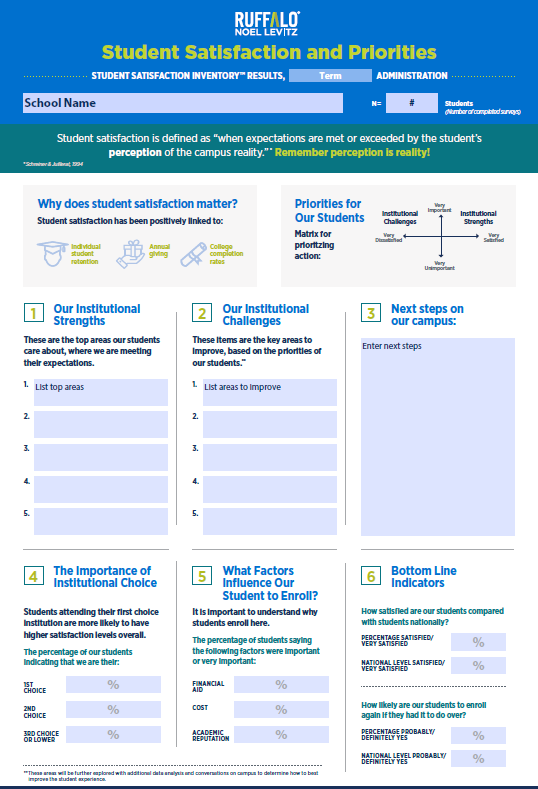student success
Why Student Satisfaction Matters for Student Success
You may be trying to build the case on campus to conduct a student satisfaction assessment, and one key reason campuses gather these data is to have a positive impact on student success and retention. We know from the research that there is a positive link between student satisfaction and higher individual student retention as well as institutional graduation rates.
But how can you use your student satisfaction data to improve student success? Here are four key ways many campuses use their data to improve student success outcomes.
1. Pay attention to campus climate items
There is a strong correlation between student satisfaction with campus climate items and overall student satisfaction. If you want to improve student success, be sure you know your students’ perceptions and satisfaction levels when it comes to areas such as:
- The campus is safe and secure for all students.
- Tuition paid is a worthwhile investment.
- It is an enjoyable experience to be a student on this campus.
- The campus staff are caring and helpful.
- This institution shows concern for students as individuals.
- Students are made to feel welcome on this campus.
- Most students feel a sense of belonging here.
Consider how your institution is performing in these areas and be intentional in improving student satisfaction as needed.
2. Celebrate your institutional strengths

RNL defines an institutional strength as an item with high importance and high satisfaction to students. These are the student experience areas that matter to students where you are also performing well. By celebrating and highlighting these areas that are specific from your student satisfaction survey results, you can positively reinforce the ways that you are delivering a great campus experience for students. Include these messages in posters on campus, announcements in campus newsletters, and on your website. You can also use your strengths to recruit and attract new students who are going to value what you are able to deliver on.
Examples of common strengths nationally include:
- Advisors and faculty being knowledgeable.
- Faculty being available after class and during office hours.
- Tutoring services being readily available and the ability for students to experience intellectual growth.
Do you know what your students identify as strengths on your campus?
3. Intentionally improve your institutional challenges
With the RNL continuous quality improvement approach, every campus has strengths to celebrate, and they also have challenges to improve. Challenges are defined as items of high importance and low satisfaction or larger performance gaps (the difference between the importance score and the satisfaction score). These areas are highly valued by your students, but they think you can be doing even better. In order to keep students enrolled at your institution, you want to show them that you are being responsive to their priority concerns by taking action to either change the student experience or change the student perception of the experience (more on that later). Challenges that are often identified nationally include:
- The ability to register for classes with few conflicts
- Financial aid access and service
- Faculty providing timely feedback on student progress.
What are the student priorities for your institution?
4. Communicate regarding changes made
The fourth way to impact student success is to actively communicate with students about your student satisfaction assessment activities and about the areas that you are working to improve on campus. This shows students that you care.
It is important to not assume that students know what you are working on and why. You want to be intentional with saying to students you said THIS on the survey and we have done THAT because we care about your experience. It is not just about gathering student satisfaction data and letting it disappear behind closed doors. You need to be sure students know what the results say and how you are using the data to guide decision making.
RNL has developed a customizable infographic to help support campus efforts with publicizing their results. How are you communicating on campus about the actions you are taking?
No action=no change in satisfaction
While all four of these steps are important to influence student satisfaction and to improve student success, the most critical step is to take action to change the student experience or their perception of the experience. We find with the campuses we work with that if they are not taking action, they are not going to see satisfaction levels improve and may actually see satisfaction levels begin to drop as students become disgruntled that the institutional leadership is not listening to their feedback. You don’t need to respond to everything on your challenge list; you just need to be intentional with actions in a few areas. As one client shared with me, “Don’t try to do everything on your challenges list. Target key areas where you can get something done.” In a similar vein, another client shared, “Targeted, specific changes can make a big impression” on students.
I recommend to client institutions that they explore three possible ways to respond to their challenge items:
- Immediate response items. These are items where you can make a change in a policy or procedure fairly easily
- Future items / strategic plan considerations. These are places where you will need more resources of time, people or money and they can’t be addressed right now but you can begin working toward a future improvement
- Change perceptions with information. These are areas where you can communicate better or differently with students about why something is the way it is or what is actually available to them, along with intentional communication on the areas where you have made an immediate change or plan to make improvements in the future.
Three examples of possible responses
Here are three examples of ways to explore and potentially respond to challenge items that I often see identified by students on the campuses we are working with.
I am able to register for classes with few conflicts.
- Explore: Data by class level; by major/program
- Focus group question: What conflicts have you experienced with registration?
- Immediate response: Add online seats for hybrid course options
- Longer term: Add sections of high demand courses with additional faculty
- Communication: Let students know the registration process for who gets access to courses when; inform on improvements made
Faculty provide timely feedback about student progress in a course.
- Explore: Data by class level; by major/program
- Focus group question: What do you consider timely feedback?
- Immediate response: Work with faculty to identify consistent response times
- Longer term: Utilize appropriate platforms for student progress
- Communication: Share with students expected response times for quizzes and papers on the syllabus; include as a footer on all faculty signature lines; frequently inform students of the expected response times
Financial aid awards are announced in time to be helpful in college planning.
- Explore: Data by class level; enrollment status (full-time / part-time)
- Focus group question: What are your experiences with financial aid?
- Immediate response: Identify gaps in service and streamline
- Longer term: Add financial aid staff as needed
- Communication: Share with students (and families) their responsibility with meeting financial aid deadlines; break financial aid info down into smaller nuggets
Look at the student satisfaction data as a gift
Once when I was reviewing survey results with a campus leadership team, the president said, “The feedback our students provide to us with the student satisfaction data is a gift that we need to take seriously and use wisely.” I couldn’t have said it better myself!
What are you going to do on your campus to use this gift to ultimately improve student success and to fulfill your mission to graduate students? Contact us to learn more about assessing and using student satisfaction on your campus.
Complimentary consultation on student satisfaction assessment
Talk to our satisfaction assessment experts about how you can easily implement the survey on your campus, including when is the best time to survey and how to get strong completion rates.


